How to Get Better at Rock Climbing: 11 Essential Tips! (2024)
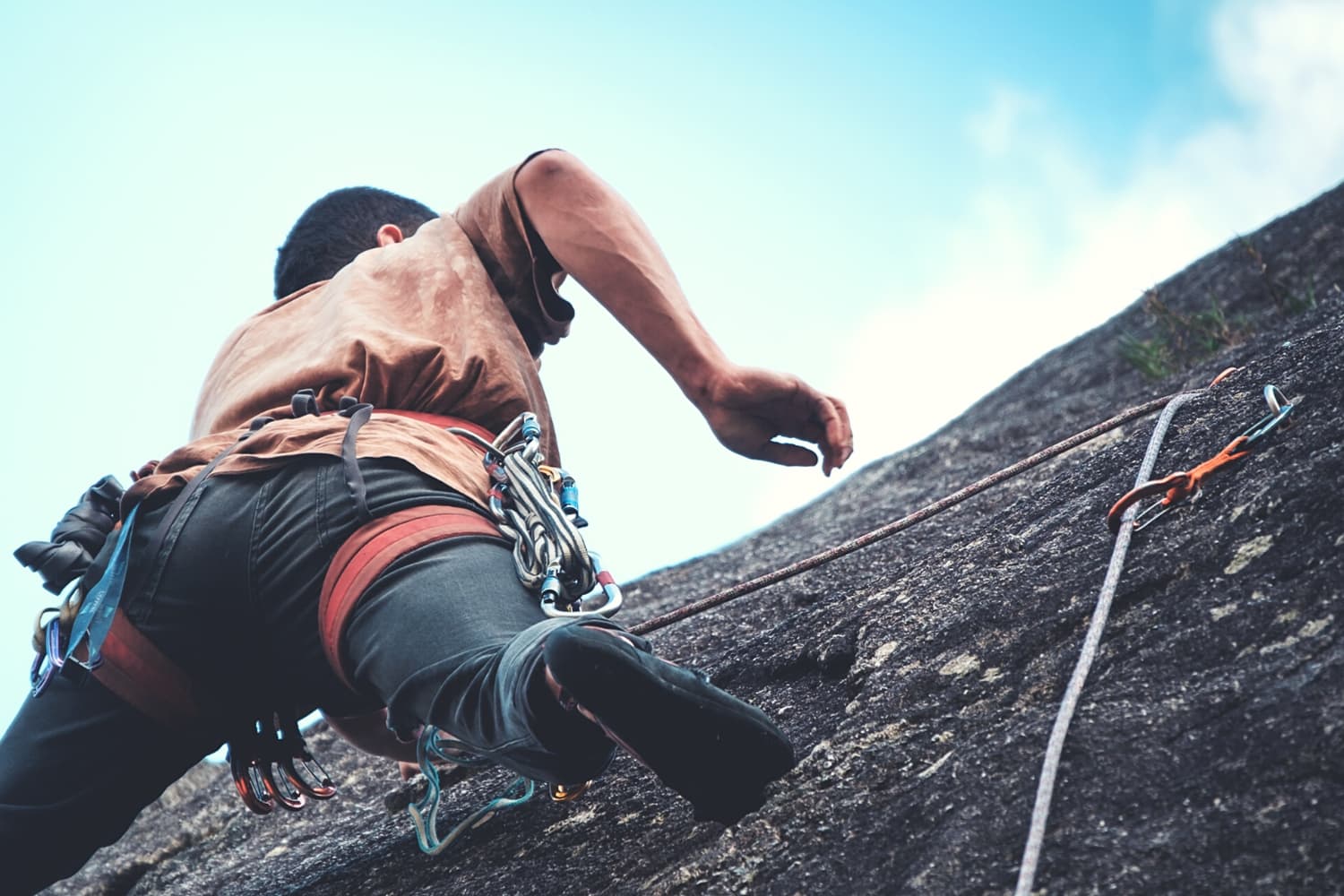
Published on: 01/15/2023
One of the reasons why we love climbing so much is the fact that you can always learn something new and get better. It’s hard to think of another activity where your improvement is so noticeable. Sure, your progress plateaus sometimes, but with a quick adjustment to the training regiment, you can improve again.
Contrary to popular belief, getting better at rock climbing is not just about developing finger strength. Instead, there are various ways to stimulate progress and get better at climbing that climbers sometimes don’t consider.
We compiled 15 essential tips to help diversify your training and tap into new ways to improve and develop a broad spectrum of climbing skills.
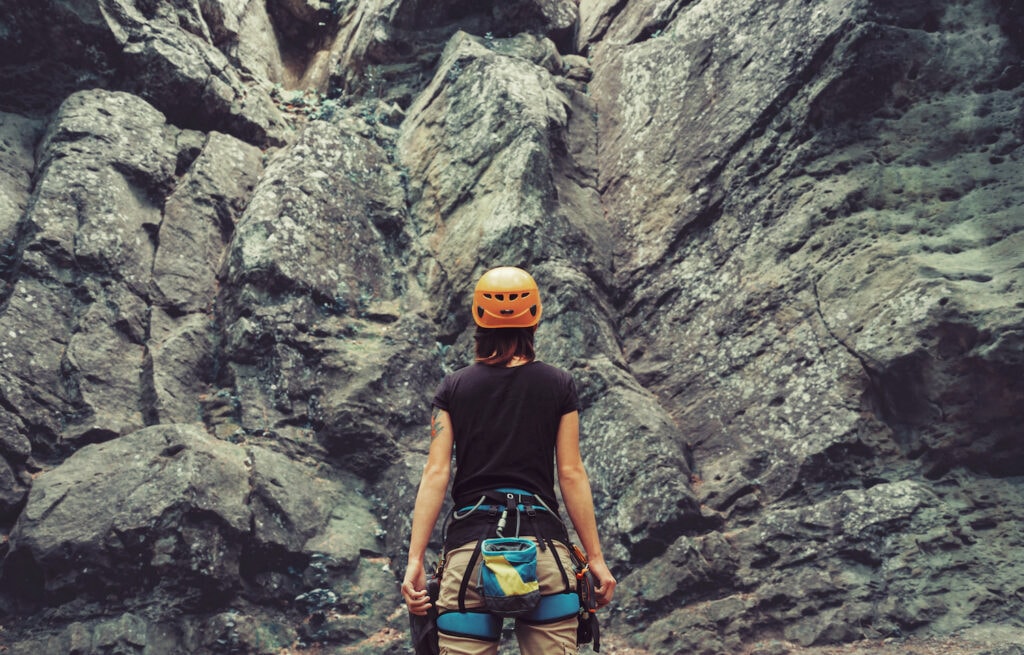
1. Practice Downclimbing
In rock climbing, the majority of our time is spent climbing upwards. When we reach the top of a climb, we drop off or top out if it’s a bouldering wall or gets lowered by our belayer on longer roped routes. We hardly spend any time downclimbing.
Downclimbing is the art of reversing the sequence you used to ascend a route. Instead of lowering or walking off the back of the boulder, you descend the climb in the same way you climbed it, only backward.
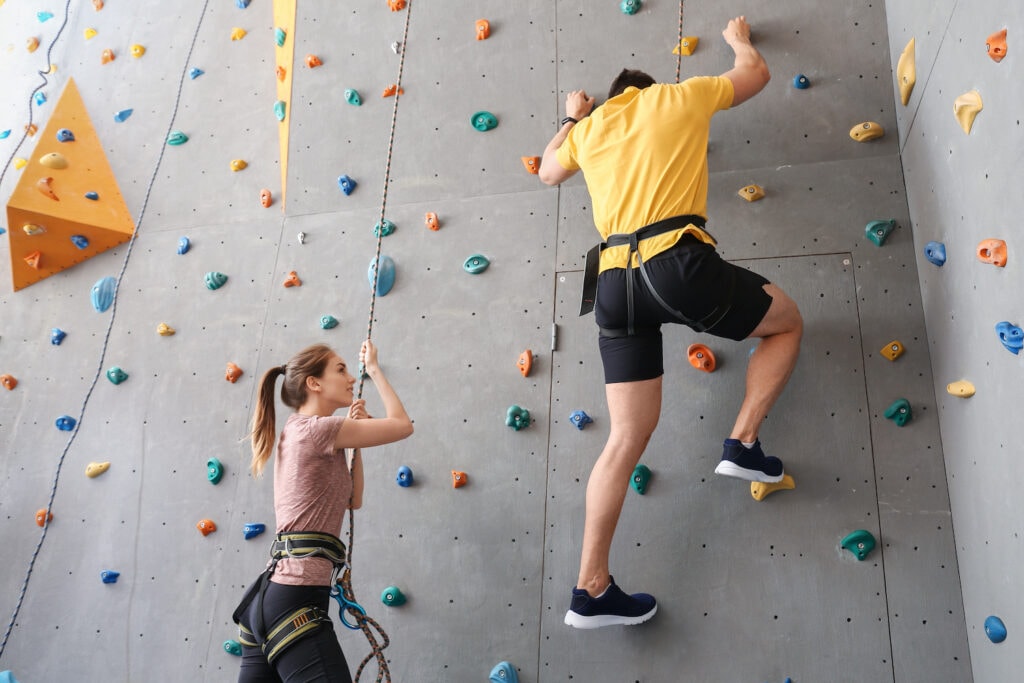
Downclimbing is a helpful skill for multiple reasons. First, it helps build endurance–the longer you are on a climb, whether it’s going up or down, the more you develop endurance.
Second, downclimbing is crucial for climbing outside, especially on longer multi-pitch routes. On long routes where the route finding may be convoluted, you need to be able to downclimb in case you climb the wrong section or decide to go another way.
2. Learn New Climbing Techniques
If you watch a group of stronger climbers, you will realize that they use their legs and feet in ways you never thought were possible. For experienced climbers with good technique, their feet and legs are like multi-tools– they can be used in various ways depending on whichever technique is best for the given moment.
In other words, they aren’t just stepping down and pushing themselves up. Instead, they may use drop knees, heel or toe hooks, flagging, and other critical techniques.
Drop knee
A drop knee is a technique that brings your hips and body closer to the wall, which is especially important on steep terrain. To drop-knee, place your toe on an edge, drop your knee inward and down towards your body, and rotate your hip into the wall as you reach up for the next hold.
Hooking
Heel and toe hooks are techniques that use other parts of the climbing shoe to gain traction. Heel hooks are fantastic for pulling your body into the wall and increasing body tension. Toe hooks allow you to pull on a foothold to increase body tension when pushing down may not be possible.
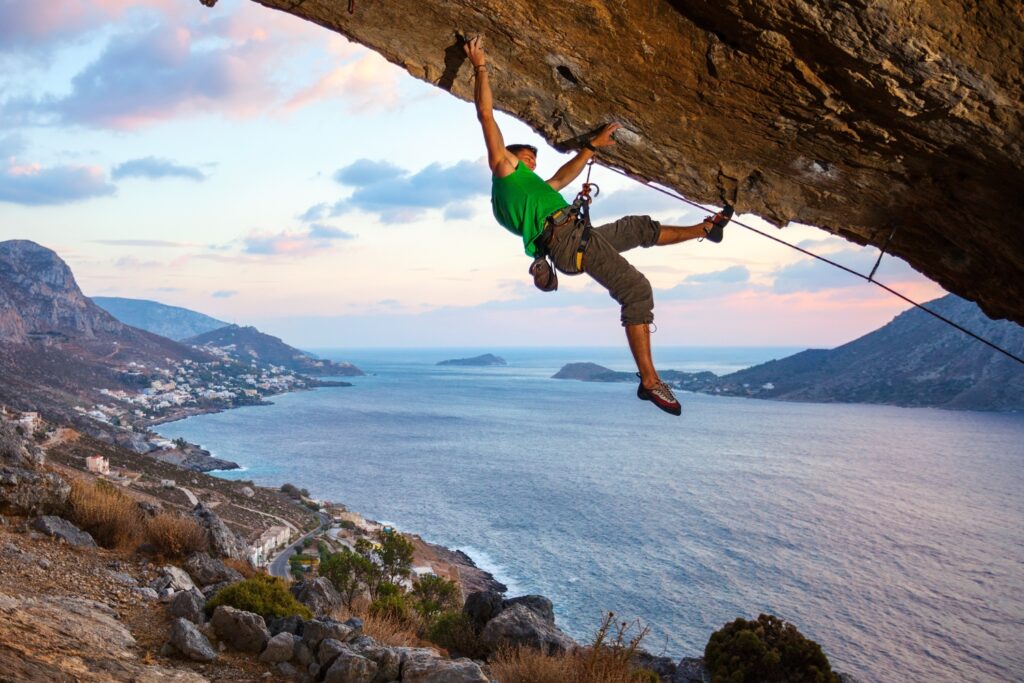
Flagging
Flagging is a technique that uses one of your legs as a counterbalance. For example, imagine a monkey’s tail as you watch it climb a tree. It waives left and right to help provide balance. You can do the same thing with your spare leg as you move through a climb.
3. Climb with “Ninja’s Feet”
As you probably already know, good footwork is one of the essential components of rock climbing. Our legs are much stronger than our arms. Our legs support our entire body weight and keep up upright despite the forces of gravity pulling down on us. Therefore, we should use that strength to push us up the wall instead of using our arms to pull us up the wall.
Think about it this way– many of us can walk up more flights of stairs than we can successfully do pull-ups.
One fun way to improve your footwork is to practice climbing with “ninja’s feet.” Ninjas are known for moving silently and for their delicate footwork. So, as you climb, pretend to be a ninja. Focus on not making a sound as you place your toes on footholds.
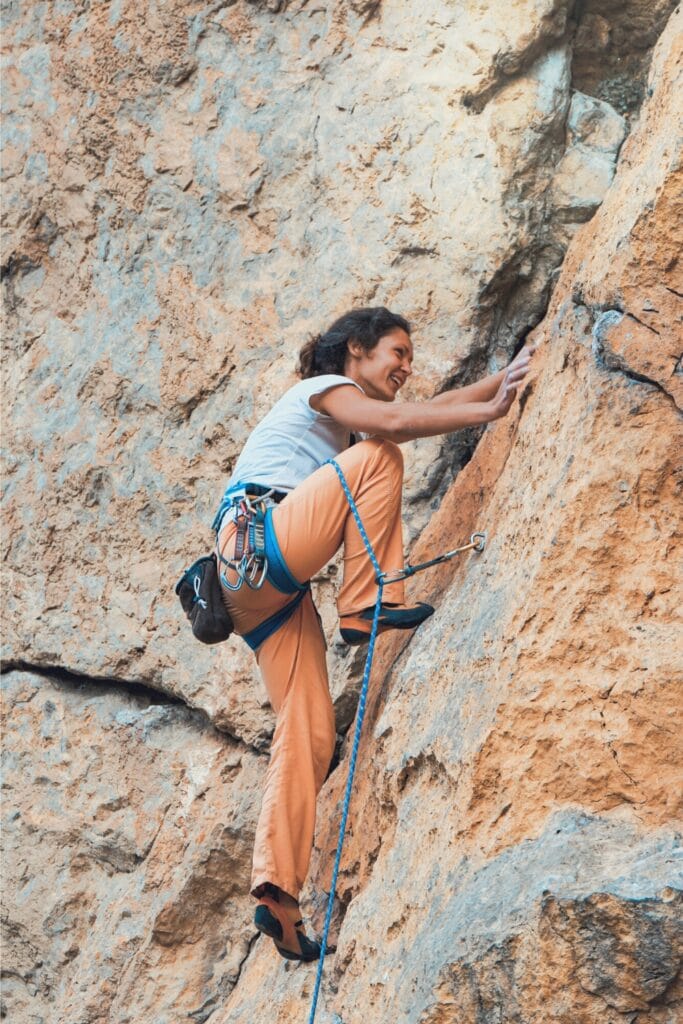
By climbing silently, you will automatically move slower. This will help improve your endurance and enhance your focus to place your feet in the best positions and use your legs to their absolute advantage. In time, your footwork will improve, and silent footwork will become part of your muscle memory.
4. Create Exciting Fitness Goals
Setting fitness goals is a great way to improve your climbing technique and stay motivated in the climbing gym. There are thousands of resources, workouts and training plans to coach you on body position, an ideal heart rate, strengthening fingers and forearms, and other climbing tips.
So we will only go into a little detail. But the following exercises are some of our favorites for improving mobility and movement and climbing technique.
Strength
Campus boards, Moon boards, and Kilter boards are all fantastic tools for building strength, improving your movement and climbing technique and breaking into more challenging grades.
However, many beginner climbers find these tools too stressful for their muscles. We recommend improving your movement and building strength with other exercises first. A good benchmark to feel comfortable on campus, Kilter, or Moon boards is bouldering v4.
Stamina and Endurance
In the beginning, one of your weaknesses will be a lack of stamina and endurance. That’s okay. That means you must train, so your shoulders and muscles don’t tucker out halfway up the route.
Many climbers will do multiple laps on top rope and auto-belays or downclimb to train endurance instead of lower from the climb.
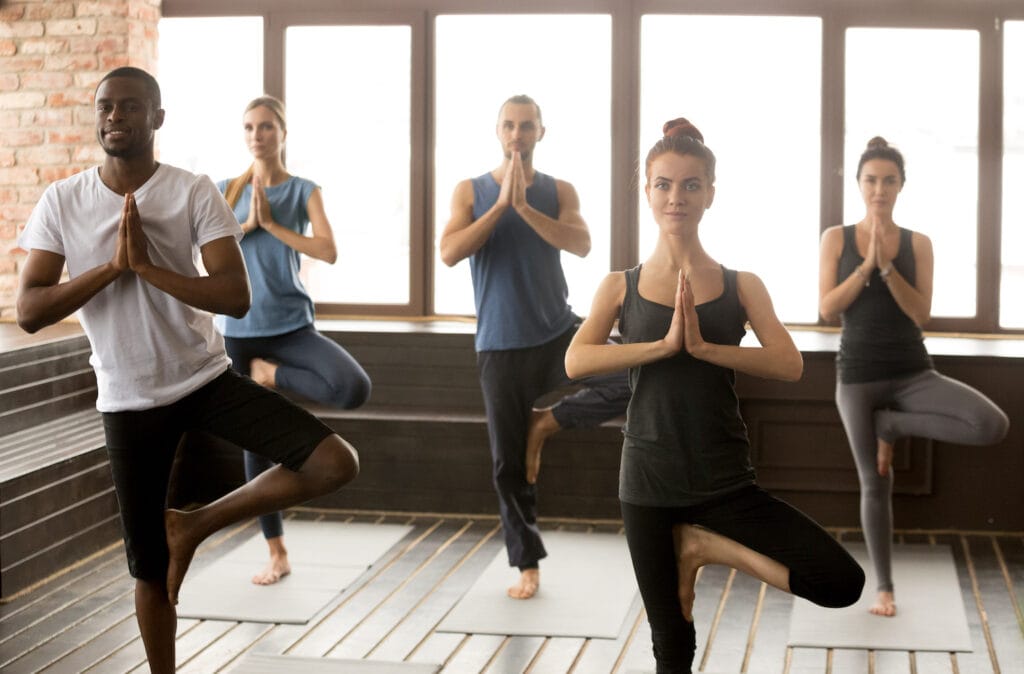
Flexibility
Climbing movement can be enhanced with greater flexibility. After your session at the climbing gym, save some time for basic stretching. Even better, try out some beginner yoga classes to get expert guidance on improving the mobility in your knees, hips, shoulders, arms, and legs.
5. Boost Your Mental Game
It’s natural to have a fear of heights. That’s why rock climbing is notorious for its mental aspect. You are intentionally participating in a sport where you must combat your fear of heights to perform well. Some say that climbing is 90% mental and only 10% physical.
One of the toughest challenges of climbing is the fear of falling. For many people, climbing up the wall is no problem. But sitting down into the harness and lowering, or falling on a hard climb, is unthinkable.
To boost your mental game and overcome your fear of falling, you have to think of falling for what it is– a skill. Falling is a skill you must practice to become comfortable with. After you’ve honed your skill, you’ll be more comfortable using your skill on the wall.
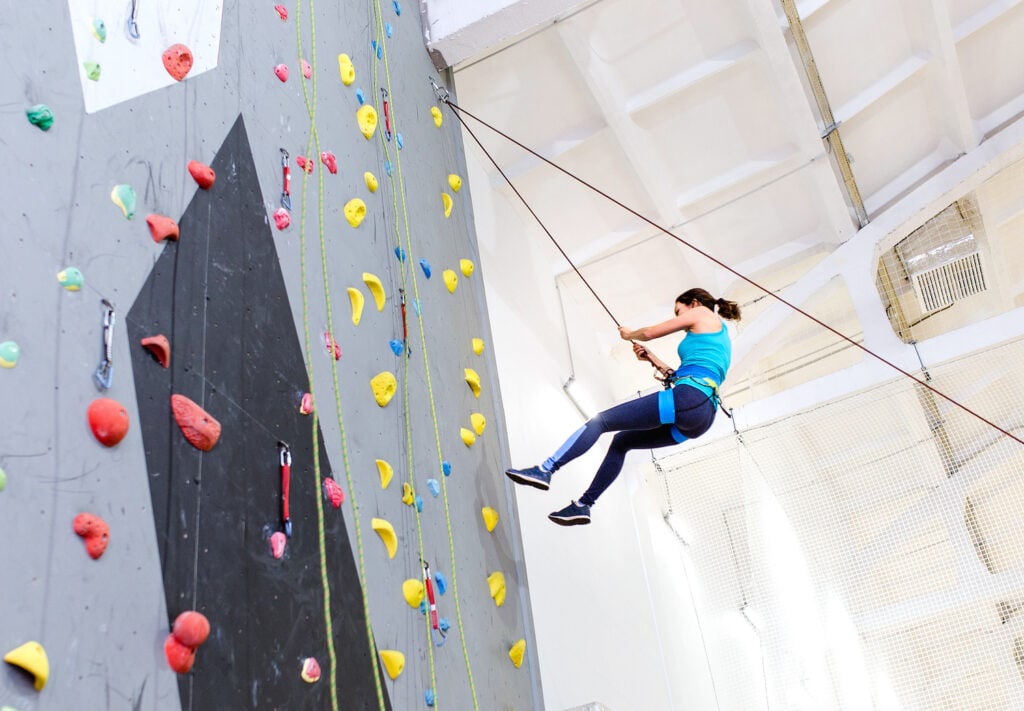
To practice falling, start on top rope. Then, climb like normal, and when you get to a section you cannot complete or get pumped, fall on the route instead of asking your belayer to take it.
After falling on top rope, practice falling on lead climbs. To practice lead falls, start by falling at the quickdraw. Then, incrementally increase the distance you climb above your last quickdraw before letting go and falling. With enough repetitions, your body will learn what to do in the event of a fall, and your brain will become more trustworthy of the system in place that keeps you safe.
6. Explore More Terrain
One of the simplest ways to become a better climber is to climb incessantly. The more time on the rock, the better.
For some, finding additional free time to climb may be challenging. But if you are one of the lucky ones, then get out there and climb!
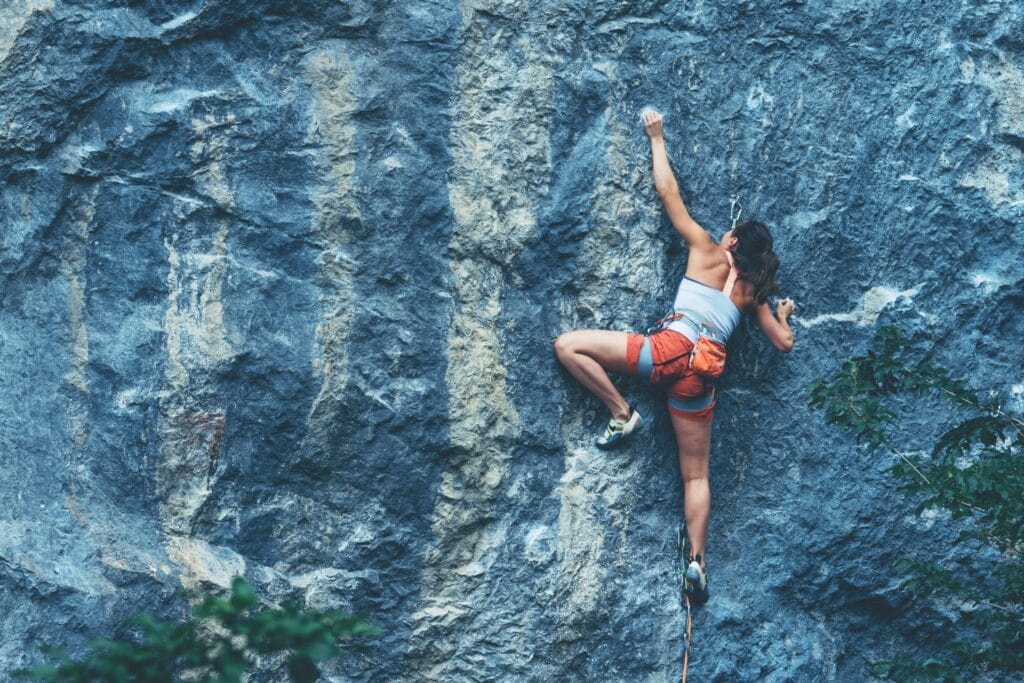
Don’t worry– you don’t have to quit your job and move into a van to explore more terrain. Just try out different rock types.
For example, try climbing outside if you are used to climbing indoors. If you only climb at your local crag, try climbing at a new one. If you love indoor climbing, try out all the gyms in your city.
Try a steep route in the cave if you adore slab climbing. If you constantly hang upside down and drop-knee on steep routes, head over to the crack wall and try hand-jamming.
Variety is the spice of life, and the same goes for climbing. The more variety you can mix into your climbing, the more versatile you will become.
7. Go Bouldering
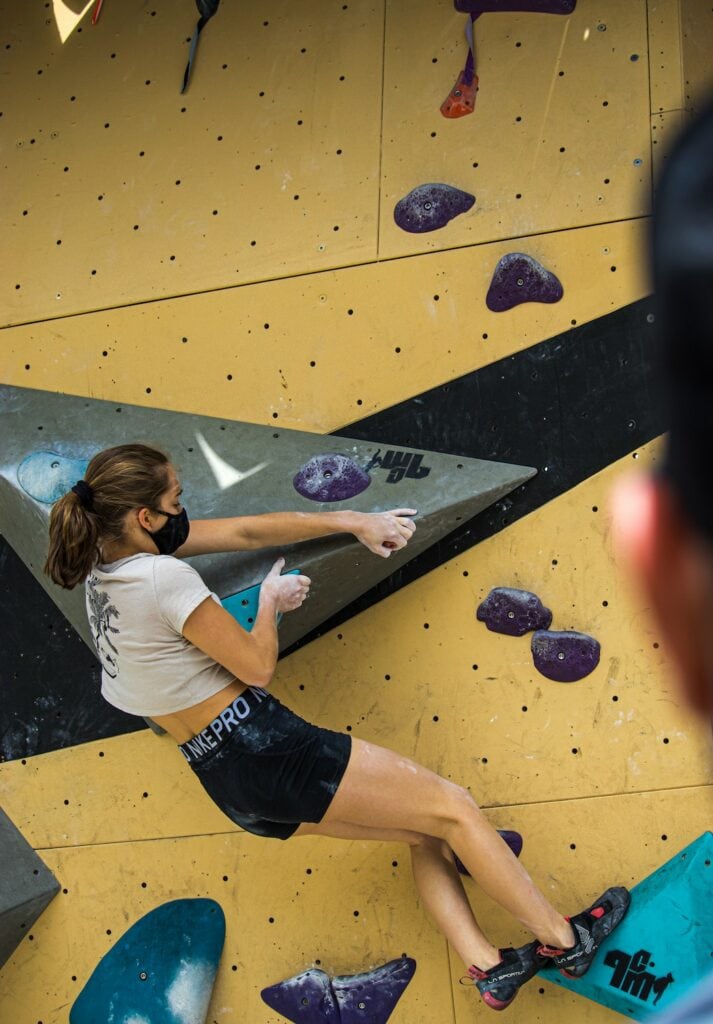
Bouldering is infamous for being too hard. But it’s one of the most effective training tools for reaching your climbing goals.f
Bouldering is hard because climbing can be powerful, acrobatic, uncomfortable, and dynamic. However, that’s precisely why bouldering is also so helpful.
Bouldering is a great way to improve your climbing technique because you can get a lot of repetitions in a limited time. As a result, you can train specific climbing moves and pack a lot into a relatively short climbing session. Eventually, you’ll be able to make the dynamic moves in the crux of your project with fewer attempts.
8. Take Classes to Learn New Skills
There is a lot to learn in the sport of climbing. And luckily, you don’t have to learn it all by yourself. In fact, we recommend the opposite. One of the best ways to improve as a climber is to learn from others with more experience.
When it comes to climbing outdoors, there are some specific core skills that you should learn before casting off on your own. As a general rule, one should be comfortable with lead climbing and belaying, anchor building and cleaning, and rappelling if you want to start climbing outside.
Learning and training these skills by yourself may sound daunting. On the other hand, if you sign up for a class or hire a guide, you can learn new skills under the supervision of a professional and avoid creating bad habits.
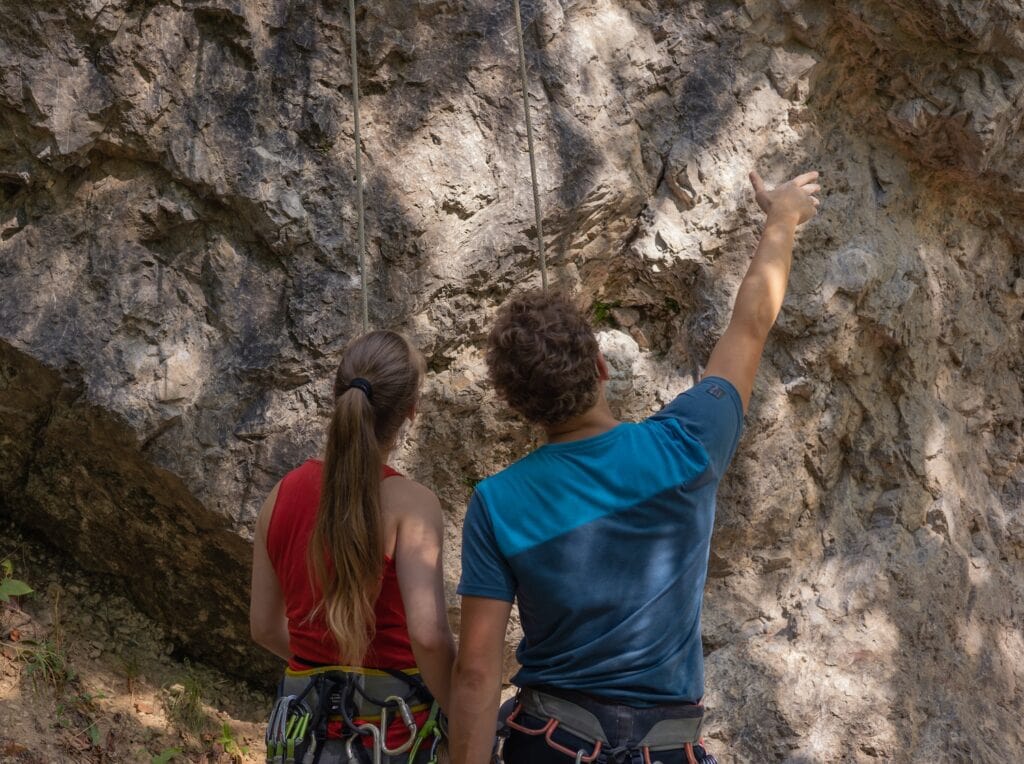
9. Incorporate a Rest Day
It’s a common misconception that resting results in losing the strength you’ve spent so long building up. So, if you have been sport climbing for the past ten days, you might need a rest day.
Rest days are beneficial for your body (1). They give your body time to recover and rebuild. Without routinely resting and recovering, you will always be running on half a tank or less.
So the next time you think you fell on your project because you lack upper body strength, try resting and sitting out on a few climbing sessions to allow your body to rebuild. Then after adequate rest, tie in a fire the rig!
Incidentally, rest of one of the three biggest tips shared by elite boulderer Drew Ruana when we asked him about his advice for beginner climbers.
10. Climb With New Friends
Another reason why we love climbing so much is the people we meet and the friends we make. The climbing community is famous for its welcoming and supportive demeanor. You can show up at the gym or crag with zero climbing partners and still make a friend and have a great time.
Climbing with new friends is not only fun and good for your social life. It’s also beneficial because you can learn from others. For example, try climbing with intermediate climbers if you are a beginner climber. If you are an intermediate climber, observe the local experts.
But of course, if you are shy or introverted and perfectly happy climbing solo or with a limited group, don’t push yourself into any uncomfortable situations.
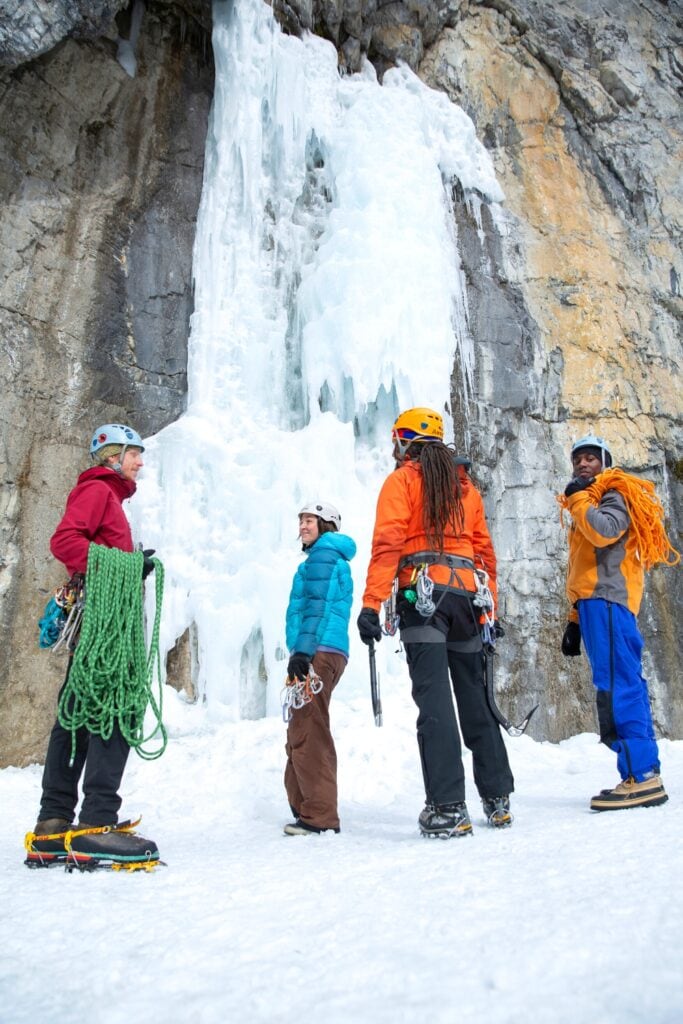
11. Track Your Progress
How do you know if you are progressing? Track your progress!
If you are just setting out, then you don’t need an intricate excel document tracking your climbing, body weight, and diet. Some might find that helpful, but many climbers can use a more straightforward system.
Instead, try out a simple notebook where you can write down what you climbed and when. It is also helpful to write down goals and notes to remember, like keeping your arms straight, maintaining your body close to the wall, trying trad climbing, and doing more pull-ups to improve upper body strength.
If you stay consistent, in about a year, you will be able to look back and see the easier routes you started with compared to the more challenging grades you currently climb. This is super helpful for gaining confidence in your ability and improving.
Final Thoughts
We’ve shared a lot of information in this article. We hope you find it helpful for your training and confidence.
But remember that what works for us may not work for you. Try out some of your recommendations and see if they mesh with your style. Then, make changes as you learn and customize your climbing to keep it fun and productive.
Lastly, if all the above fails or you don’t know where to start, it may be time to hire a climbing coach to get you out of the plateau zone.
Have fun, and always remember your double-checks!
References
Are Rest Days Important for Exercise?
Kirsten Nunez, Daniel Bubnis, M.S.
Healthline (retrieved on 01/15/2023)
https://www.healthline.com/health/exercise-fitness/rest-day
